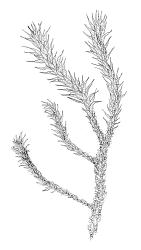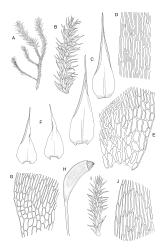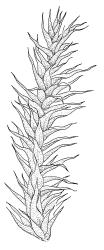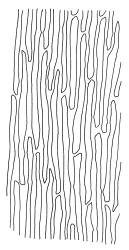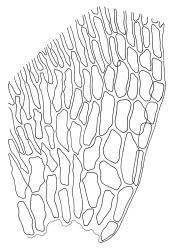- ≡ Hypnum stellatum Hedw., Sp. Musc. Frond. 280 (1801)
- ≡ Campylium stellatum (Hedw.) C.E.O.Jensen, Meddel. Grønland 3: 328 (1887)
Plants rather robust, yellow-, brown- or red-green, lustrous when dry. Stems ascendant, irregularly and often sparsely branched, mostly c. 50–100 mm, in cross-section with 2–5 layers of small, incrassate cortical cells and a small central strand, apparently lacking rhizoids. Stem leaves widely-spreading to squarrose, not secund, weakly sheathing at base, lanceolate and ± evenly tapered to apex, entire, channelled above, (2.3–)2.8–3.5 × (0.8–)0.85–1.0 mm, striolate when dry; mid laminal cells vermicular, mostly 40–75(–90) × 4–5 µm, incrassate and porose, the cell walls often ± equal the lumina in width, very weakly projecting at ends; alar cells numerous, forming a large ± auriculate group extending c. ¼ the leaf width, inflated, hyaline or pigmented in extreme angles, surrounded by incrassate, subquadrate, and orange-pigmented supra-alar cells. Costa inconspicuous and variable, either absent, or very weak and single or double. Branch leaves more abruptly and more narrowly acuminate and usually shorter than stem leaves, with the alar group usually smaller. Pseudoparaphyllia usually wider than long and rounded at apex.
Dioicous. Sex organs and capsules not seen in N.Z. material.
Kanda 1976, fig. 29, 1–12; Crum & Anderson 1981, fig. 461, A–G (as Campylium stellatum); Smith 2004, fig. 255, 1–4 (as Campylium stellatum).
Campyliadelphus stellatus is a more robust and more strongly pigmented plant than C. polygamus, the species with which confusion is most likely. By its dimensions (especially leaf width), widely-spreading or squarrose and evenly tapered, and apparently (under the hand lens) ecostate leaves, this species is easily recognised. Its association with high elevation seepages or flushes and its usually gold-brown colouration also help to distinguish it. While sharing some characteristics with Cratoneuropsis relaxa, in overall habit the plants are very different.
SI: Nelson, Canterbury, Otago (Old Man Range).
Bipolar. Widespread in the northern hemisphere and reported from Colombia (Hedenäs 2003).
On damp soil in alpine and montane areas, most frequently in mesotrophic flushes with Schoenus pauciflorus and often Caltha novae-zelandiae, less often at margins of boggy pools and in damp Chionochloa rubra grasslands. Occurring most commonly from c. 900–1580 m a.s.l. (St. Arnaud Range, Nelson L.D.), but occasionally found as low as c. 400 m in seeps over calcareous sand or marl (as at Broken River, Canterbury L.D.). Frequently associated moss species at higher altitudes include Breutelia pendula, Distichophyllum kraussei, Fissidens adianthoides, and Scorpidium cossonii, while at lower altitudes Dicranella cardotii is often associated.
Campyliadelphus stellatus is one of several relatively conspicuous paludal species which, for inexplicable reasons, were not found by 19th or early 20th century collectors. The earliest N.Z. collection of C. stellatus appears to be a 1962 gathering by C.J. Burrows (CHR 578057) in the Craigieburn Range, Canterbury L.D. The absence of older collections of this relatively conspicuous species is curious and the probability that it might be adventive cannot be entirely ruled out, despite the fact that it appears to be strongly integrated in indigenous vegetation.



